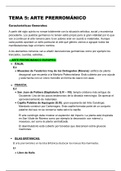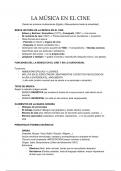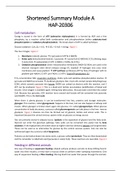Corporate Finance
Lecture 1| Accounting recap: balance sheet,
income statement and cash flow statement
Operating activity = means what is a company doing, why was it really created, what is its
main purpose?
Balance sheet
A balance sheet has two sites:
1. Assets: all the stuff that belongs to a company that they keep with the idea of using it
somehow to generate revenue. So it is likely that it will generate a future economic
benefit.
○ Current assets: all the assets that stay in the company for less than 1 year.
■ Cash & cash equivalent
■ Accounts receivable: somebody else owes us money. They have to
pay this back to us within one year or less.
■ Inventory
■ → Who? Customers and other companies
○ Fixed assets (non-current assets): all the assets that stay in a company for
more than 1 year.
■ Property, plant and equipment (PPE)
■
Each item on the balance sheet comes with a number.
Historic costs: how much should the company originally pay for their asset?
○ Example: a company buys a piece of land for 100 euros 10 years ago. It will
be put on the balance sheet by PPE as 100. This amount doesn’t mean that if
they were to sell this piece of land, that they would get 100.
○ Total assets sum = ∑
2. Liabilities + owners equity
Liabilities = we (our company) have borrowed money from someone else.
● Current Liabilities: money that we have to pay back within 1 year or less.
● Non Current Liabilities: money that is from someone else that we have to
pay back with a period of more than 1 year.
→ DEBT
+
, Owners equity = the capital that has been provided by its shareholders. Is when
shareholders buy stocks of the company in the context of an IPO (initial Public
Offering).
● Common Stock (shares)
● Retained Earnings: it is simply profit the company generated in the past that
has not been paid out to the shareholders. So, the dividend that is left in the
company.
→ EQUITY
Both sides of the balance sheet have to be equal. It cannot be that they differ.
Income statement
Income statement = profit and loss account (P&L)
● Revenue: the money that the company generates from providing the service or
selling the product.
● COGS: is direct material, direct labor and manufacturing overhead, which is all the
stuff that is necessary to create the product or provide the service.
● Gross Profit: revenue - COGS.
● Operating Expenses: stuff like salary.
● Operating Profit (Earnings before interest and Taxes = EBIT): gross profit -
operating expenses.
Revenue
Cost of Goods Sold (COGS) -
________________________
Gross Profit
Operating Expenses -
________________________
Operating Profit (EBIT)
Interest Expenses - (Or + interest income)
________________________
Earnings Before Taxes
Tax (Tc) -
________________________
Net income (profit or loss)
Net income at the end of the year is moved to the retained earnings. In this way, the
balance sheet is connected with the income statement. During the year, we don’t really book
in the balance sheet. We book in the income statement all the things that we sell and
expenses. And at the end of the year, when net income is moved, we update the balance
sheet and that is the closing balance sheet.
● A positive net income (profit), increases the retained earnings and by extension
equity, making the company more valuable.
● A negative income (loss), reduces the retained earnings and equity, making the
company less valuable.
,DIFFERENCE DEPRECIATION AND AMORTIZATION
Instead of dividing the balance sheet into current and noncurrent assets, you could also
divide it based on tangible and intangible assets.
● Tangible assets: assets that we can touch.
● Intangible assets: assets that we cannot touch (trademark, goodwill).
Depreciation = the loss of value of a fixed asset, because you used it.
● Will probably be in the operating expenses on the income statement.
● If it is directly related to the production process, it would be in the COGS and the
overhead costs.
● For tangible assets.
Example: Car 100 euro
Use for life is 10 years
Annual depreciation expense = PP / UL = 100 euro / 10 years = 10 euro
Amortization = the same as depreciation but then for intangible assets.
Example: License to use a Microsoft product for 100 euros
Use of life is 10 years
Annual amortization expense = same calculation as depreciation but you call
it annual amortization expense
Cash flow statement
The cash flow statement is divided into three sections. In each section, you can only find
two different kinds of entries: cash inflows (+) and cash outflows (-).
1. Cash flow from operating activity: that is where we keep track of inflows and
outflows that directly recycles the operating activity. This mostly takes part of the top
part of the income statement.
+ all revenue
- all expenses
=…
2. Cash flow from investing activity: is the residue of transactions within the fixed
assets.
+ …
- …
=
3. Cash flow from financing activity: refers to the right side of the balance sheet.
+ …
- …
=…
After you all checked the cash inflows and outflows, you can sum them all up. First per
section and after that all together: cash flow from operating + investing + financing. This is
only the changing cash throughout the year and will be on the balance sheet by cash but it is
cash from last year’s balance sheet + cash from the cash flow statement.
, Cash flow from operating activities - You cannot say that something is good or bad by just
looking at the number. To do that, you should compare it with other companies. But what we
can see is that, if the cash flows from operating activity is a positive amount, all the operating
activities (= the purpose of why a company exists) are generating cash (not necessarily
profit).
Cash flow from investing activities - Cash flow from investing activities has to do something
with fixed assets transactions. Which cash inflows from investing is what we have if we sell
assets, which outflows is when we buy assets. So when the cash flow from investing
activities is negative, it implies that they report and pay in cash more assets than we sold the
asset. How much more is the negative amount from the cash flow. This is good, because the
company is probably growing and that is why they purchase more assets to expand and
open new shops for example.
Cash flow from financing activities - The cash flow from financing activities include that the
company has obtained cash from either borrowing or issuing equity.
The cash flow statement and the income statement are NOT the same thing. In the income
statement we are tracking earnings and expenses, but we are not interested in cash
effectiveness. Cash flow statements looks at cash inflows and cash outflows.
Lecture 1| Accounting recap: balance sheet,
income statement and cash flow statement
Operating activity = means what is a company doing, why was it really created, what is its
main purpose?
Balance sheet
A balance sheet has two sites:
1. Assets: all the stuff that belongs to a company that they keep with the idea of using it
somehow to generate revenue. So it is likely that it will generate a future economic
benefit.
○ Current assets: all the assets that stay in the company for less than 1 year.
■ Cash & cash equivalent
■ Accounts receivable: somebody else owes us money. They have to
pay this back to us within one year or less.
■ Inventory
■ → Who? Customers and other companies
○ Fixed assets (non-current assets): all the assets that stay in a company for
more than 1 year.
■ Property, plant and equipment (PPE)
■
Each item on the balance sheet comes with a number.
Historic costs: how much should the company originally pay for their asset?
○ Example: a company buys a piece of land for 100 euros 10 years ago. It will
be put on the balance sheet by PPE as 100. This amount doesn’t mean that if
they were to sell this piece of land, that they would get 100.
○ Total assets sum = ∑
2. Liabilities + owners equity
Liabilities = we (our company) have borrowed money from someone else.
● Current Liabilities: money that we have to pay back within 1 year or less.
● Non Current Liabilities: money that is from someone else that we have to
pay back with a period of more than 1 year.
→ DEBT
+
, Owners equity = the capital that has been provided by its shareholders. Is when
shareholders buy stocks of the company in the context of an IPO (initial Public
Offering).
● Common Stock (shares)
● Retained Earnings: it is simply profit the company generated in the past that
has not been paid out to the shareholders. So, the dividend that is left in the
company.
→ EQUITY
Both sides of the balance sheet have to be equal. It cannot be that they differ.
Income statement
Income statement = profit and loss account (P&L)
● Revenue: the money that the company generates from providing the service or
selling the product.
● COGS: is direct material, direct labor and manufacturing overhead, which is all the
stuff that is necessary to create the product or provide the service.
● Gross Profit: revenue - COGS.
● Operating Expenses: stuff like salary.
● Operating Profit (Earnings before interest and Taxes = EBIT): gross profit -
operating expenses.
Revenue
Cost of Goods Sold (COGS) -
________________________
Gross Profit
Operating Expenses -
________________________
Operating Profit (EBIT)
Interest Expenses - (Or + interest income)
________________________
Earnings Before Taxes
Tax (Tc) -
________________________
Net income (profit or loss)
Net income at the end of the year is moved to the retained earnings. In this way, the
balance sheet is connected with the income statement. During the year, we don’t really book
in the balance sheet. We book in the income statement all the things that we sell and
expenses. And at the end of the year, when net income is moved, we update the balance
sheet and that is the closing balance sheet.
● A positive net income (profit), increases the retained earnings and by extension
equity, making the company more valuable.
● A negative income (loss), reduces the retained earnings and equity, making the
company less valuable.
,DIFFERENCE DEPRECIATION AND AMORTIZATION
Instead of dividing the balance sheet into current and noncurrent assets, you could also
divide it based on tangible and intangible assets.
● Tangible assets: assets that we can touch.
● Intangible assets: assets that we cannot touch (trademark, goodwill).
Depreciation = the loss of value of a fixed asset, because you used it.
● Will probably be in the operating expenses on the income statement.
● If it is directly related to the production process, it would be in the COGS and the
overhead costs.
● For tangible assets.
Example: Car 100 euro
Use for life is 10 years
Annual depreciation expense = PP / UL = 100 euro / 10 years = 10 euro
Amortization = the same as depreciation but then for intangible assets.
Example: License to use a Microsoft product for 100 euros
Use of life is 10 years
Annual amortization expense = same calculation as depreciation but you call
it annual amortization expense
Cash flow statement
The cash flow statement is divided into three sections. In each section, you can only find
two different kinds of entries: cash inflows (+) and cash outflows (-).
1. Cash flow from operating activity: that is where we keep track of inflows and
outflows that directly recycles the operating activity. This mostly takes part of the top
part of the income statement.
+ all revenue
- all expenses
=…
2. Cash flow from investing activity: is the residue of transactions within the fixed
assets.
+ …
- …
=
3. Cash flow from financing activity: refers to the right side of the balance sheet.
+ …
- …
=…
After you all checked the cash inflows and outflows, you can sum them all up. First per
section and after that all together: cash flow from operating + investing + financing. This is
only the changing cash throughout the year and will be on the balance sheet by cash but it is
cash from last year’s balance sheet + cash from the cash flow statement.
, Cash flow from operating activities - You cannot say that something is good or bad by just
looking at the number. To do that, you should compare it with other companies. But what we
can see is that, if the cash flows from operating activity is a positive amount, all the operating
activities (= the purpose of why a company exists) are generating cash (not necessarily
profit).
Cash flow from investing activities - Cash flow from investing activities has to do something
with fixed assets transactions. Which cash inflows from investing is what we have if we sell
assets, which outflows is when we buy assets. So when the cash flow from investing
activities is negative, it implies that they report and pay in cash more assets than we sold the
asset. How much more is the negative amount from the cash flow. This is good, because the
company is probably growing and that is why they purchase more assets to expand and
open new shops for example.
Cash flow from financing activities - The cash flow from financing activities include that the
company has obtained cash from either borrowing or issuing equity.
The cash flow statement and the income statement are NOT the same thing. In the income
statement we are tracking earnings and expenses, but we are not interested in cash
effectiveness. Cash flow statements looks at cash inflows and cash outflows.





